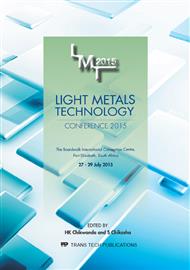[1]
T. Hussain, A study of bonding mechanisms and corrosion behaviour of cold sprayed coatings, University of Nottingham, (2011).
Google Scholar
[2]
X. Goso and a. Kale, Production of titanium metal powder by the HDH process, Journal of the Southern African Institute of Mining and Metallurgy, vol. 111, no. MARCH, p.203–210, (2011).
Google Scholar
[3]
T. Hussain, D. G. McCartney, P. H. Shipway, and T. Marrocco, Corrosion behavior of cold sprayed titanium coatings and free standing deposits, Journal of Thermal Spray Technology, vol. 20, no. 1–2, p.260–274, Aug. (2011).
DOI: 10.1007/s11666-010-9540-x
Google Scholar
[4]
T. Hussain, Cold Spraying of Titanium: A Review of Bonding Mechanisms, Microstructure and Properties, Key Engineering Materials, vol. 533, p.53–90, Dec. (2012).
DOI: 10.4028/www.scientific.net/kem.533.53
Google Scholar
[5]
V. K. Champagne, The cold spray materials deposition process Fundamentals and applications. England: Woodhead Publishing Limited, (2007).
Google Scholar
[6]
A. Papyrin, V. Kosarev, S. Klinkov, A. Alkimov, and V. Fomin, High-velocity interaction of particles with the substrate. Experiment and modeling. Elsevier, (2007).
DOI: 10.1016/b978-008045155-8/50002-8
Google Scholar
[7]
W. -Y. Li, G. Zhang, H. L. Liao, and C. Coddet, Characterizations of cold sprayed TiN particle reinforced Al2319 composite coating, Journal of Materials Processing Technology, vol. 202, no. 1–3, p.508–513, Jun. (2008).
DOI: 10.1016/j.jmatprotec.2007.09.045
Google Scholar
[8]
S. Tria, O. Elkedim, R. Hamzaoui, X. Guo, F. Bernard, N. Millot, and O. Rapaud, Deposition and characterization of cold sprayed nanocrystalline NiTi, Powder Technology, vol. 210, no. 2, p.181–188, Jun. (2011).
DOI: 10.1016/j.powtec.2011.02.026
Google Scholar
[9]
V. Champagne, S. Dinavahi, and P. Leyman, Prediction of Particle Velocity for the Cold Spray Process (ARL-TR-5683), no. September, (2011).
Google Scholar
[10]
H. Tabbara, S. Gu, D. G. McCartney, T. S. Price, and P. H. Shipway, Study on process optimization of cold gas spraying, Journal of Thermal Spray Technology, vol. 20, no. 3, p.608–620, Oct. (2011).
DOI: 10.1007/s11666-010-9564-2
Google Scholar
[11]
LAMMPS Molecular Dynamics Simulator., [Online]. Available: http: /lammps. sandia. gov/. [Accessed: 19-Jul-2014].
Google Scholar
[12]
P. Valentini and T. Dumitrica, Molecular Dynamics Simulations of Nanoparticle-Surface Collisions in Crystalline Silicon, vol. 1, p.31–39, (2008).
DOI: 10.4028/www.scientific.net/jnanor.1.31
Google Scholar
[13]
M. Grujicic, J. R. Saylor, D. E. Beasley, W. S. DeRosset, and D. Helfritch, Computational analysis of the interfacial bonding between feed-powder particles and the substrate in the cold-gas dynamic-spray process, Applied Surface Science, vol. 219, no. 3–4, p.211–227, Dec. (2003).
DOI: 10.1016/s0169-4332(03)00643-3
Google Scholar
[14]
J. Li, 2. 8 basic molecular dynamics, in Handbook of Materials Modeling, Springer, 2005, p.565–588.
Google Scholar
[15]
D. C. Rapaport, The Art of Molecular Dynamics Simulation. Cambridge University Press, (2004).
Google Scholar
[16]
G. J. Ackland, Theoretical study of titanium surfaces and defects with a new many-body potential, Philosophical Magazine A, vol. 66. p.917–932, (1992).
DOI: 10.1080/01418619208247999
Google Scholar
[17]
Ackland G. J., Ni (fcc) Pair Potential Parameters.
Google Scholar
[18]
H. Lee and W. Cai, Ewald summation for Coulomb interactions in a periodic supercell, Lecture Notes, Stanford University, vol. 3, no. 1, p.1–12, (2009).
Google Scholar
[19]
U. Essmann, L. Perera, M. L. Berkowitz, T. Darden, H. Lee, and L. G. Pedersen, A smooth particle mesh Ewald method, J Chem Phys, vol. 103, no. November, p.8577–8593, (1995).
DOI: 10.1063/1.470117
Google Scholar
[20]
K. A. Dill, S. Bromberg, and D. Stigter, Molecular Driving Forces. New York: Garland Science, (2003).
Google Scholar
[21]
V. V. Ivanov and V. K. Zadiraka, Numerical optimization, 2nd ed., vol. 9, no. 4. Springer Science & Business Media, (2006).
Google Scholar
[22]
LAMMPS-ICMS Users Manual, no. 2003, Sandia National Laboratories, (2014).
Google Scholar
[23]
S. Patel, A. D. Mackerell, and C. L. Brooks, CHARMM fluctuating charge force field for proteins: II protein/solvent properties from molecular dynamics simulations using a nonadditive electrostatic model., Journal of computational chemistry, vol. 25, no. 12, p.1504–14, Sep. (2004).
DOI: 10.1002/jcc.20077
Google Scholar
[24]
T. Goyal, R. S. Walia, and T. S. Sidhu, Multi-response optimization of low-pressure cold-sprayed coatings through Taguchi method and utility concept, International Journal of Advanced Manufacturing Technology, vol. 64, no. 5–8, p.903–914, Mar. (2013).
DOI: 10.1007/s00170-012-4049-8
Google Scholar
[25]
B. Hills, DOE-I Basic Design of Experiments. nutek, inc., (2008).
Google Scholar
[26]
F. Raletz, M. Vardelle, and G. Ezo'o, Critical particle velocity under cold spray conditions, Surface and Coatings Technology, vol. 201, no. 5, p.1942–1947, Oct. (2006).
DOI: 10.1016/j.surfcoat.2006.04.061
Google Scholar
[27]
Y. Zou, Microstructural Studies of Cold Sprayed Pure Nickel , Copper and Aluminum Coatings, McGill University, (2010).
Google Scholar
[28]
M. Grujicic, C. L. Zhao, W. S. DeRosset, and D. Helfritch, Adiabatic shear instability based mechanism for particles/substrate bonding in the cold-gas dynamic-spray process, Materials and Design, vol. 25, p.681–688, (2004).
DOI: 10.1016/j.matdes.2004.03.008
Google Scholar


